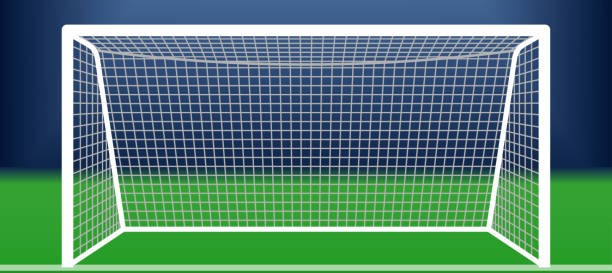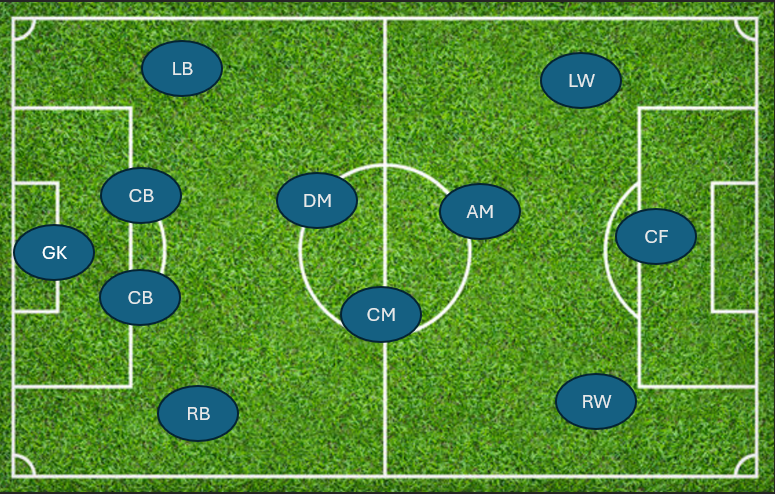













FOOTBALL FORMATIONS.

Football formations are strategic arrangements of players on the field, designed to maximize a team's
strengths and exploit the opponent's weaknesses. Formations define how players are positioned and how they balance
between offense, defense, and midfield roles. Here's a detailed explanation of some common football formations:
4-4-2 Formation:
- ▫ SETUP: 4 defenders, 4 midfielders, 2 forwards.
- ▫ DESCRIPTION: This is one of the most traditional and balanced formations. The defense consists of 2 center backs
and 2 full-backs, while the midfield typically has 2 central midfielders and 2 wide midfielders or wingers.
The 2 forwards focus on attacking and goal-scoring.
- ▫ STRENGTHS: Balanced between defense and attack. Provides width from the wingers and good support for forwards.
- ▫ WEAKNESSES: Can be overrun in midfield if the opponent plays with more midfielders.
4-3-3 Formation:
- ▫ SETUP: 4 defenders, 3 midfielders, 3 forwards.
- ▫ DESCRIPTION: Popular in attacking play, with 4 defenders and 3 midfielders (often a combination of defensive
and attacking roles). The 3 forwards are usually composed of a central striker and two wide wingers.
- ▫ STRENGTHS: Strong attacking potential with three forwards. It stretches the opposition defense with wide wingers
and creates more goal-scoring opportunities.
- ▫ WEAKNESSES: Leaves space in midfield if the three midfielders are not well-organized or if they lack defensive support.
4-2-3-1 Formation:
- ▫ SETUP: 4 defenders, 2 defensive midfielders, 3 attacking midfielders, 1 forward.
- ▫ DESCRIPTION: This formation is commonly used to balance defensive stability and attacking flair.
The two defensive midfielders protect the backline, while the three attacking midfielders support the lone forward.
- ▫ STRENGTHS: Offers solid defense with the two holding midfielders, while also allowing attacking creativity from the
3 advanced midfielders. Flexible for transitions between defense and attack.
- ▫ WEAKNESSES: Heavily relies on the lone striker for scoring, and midfielders need to support the attack constantly
3-5-2 Formation:
- ▫ SETUP: 3 defenders, 5 midfielders, 2 forwards.
- ▫ DESCRIPTION: In this formation, there are 3 central defenders, with 5 midfielders including wing-backs who operate on
the flanks, providing both defense and attack. The 2 forwards focus on offensive play.
- ▫ STRENGTHS: Provides dominance in midfield and gives the team control of the ball. Wing-backs offer width,
and the two forwards can work in tandem for attacking opportunities.
- ▫ WEAKNESSES: Defensively risky if the wing-backs are caught too far forward, leaving space behind for opponents to exploit.
3-4-3 Formation:
- ▫ SETUP: 3 defenders, 4 midfielders, 3 forwards
- ▫ DESCRIPTION: This formation is designed for attacking play. The 3 defenders are usually center backs, while
the 4 midfielders include wing-backs or wide players that support both offense and defense. The 3 forwards are key to a strong
attacking presence.
- ▫ STRENGTHS: Offers aggressive attacking play with 3 forwards and wide support from the midfield. The wing-backs provide width
and create goal-scoring chances.
- ▫ WEAKNESSES: Vulnerable to counter-attacks, especially if the midfielders are not quick to transition back into defense.
4-1-4-1 Formation:
- ▫ SETUP: 4 defenders, 1 defensive midfielder, 4 midfielders, 1 forward.
- ▫ DESCRIPTION: This formation focuses on having a defensive midfielder to shield the back four, while the midfield
provides offensive support. The lone striker stays up top to finish attacks.
- ▫ STRENGTHS: Provides strong defensive stability with the lone defensive midfielder. It can absorb pressure and
then counter-attack effectively with the 4 midfielders pushing forward.
- ▫ WEAKNESSES: Relies heavily on the lone striker for scoring, and the midfielders must transition quickly to provide offensive support.
5-3-2 Formation:
- ▫ SETUP: 5 defenders, 3 midfielders, 2 forwards.
- ▫ DESCRIPTION: Often referred to as the “defensive” formation, it uses 5 defenders with wing-backs who can push forward into the attack.
The midfield is usually compact, and the 2 forwards play a pivotal role in attacking.
- ▫ STRENGTHS: Very strong defensively, especially against teams that rely on wingers or wide play. The wing-backs can add attacking
support without sacrificing defensive shape
- ▫ WEAKNESSES: Can be too defensive if the wing-backs don't push forward enough. It can also isolate the 2 forwards
if the team is too focused on defense.
4-4-1-1 Formation:
- ▫ SETUP: 4 defenders, 4 midfielders, 1 attacking midfielder, 1 forward.
- ▫ DESCRIPTION: Similar to the 4-4-2 but with one forward playing slightly deeper in a more creative,
playmaking role behind the main striker.
- ▫ STRENGTHS: Adds an extra layer of creativity and fluidity to the attack with the playmaker positioned behind the striker.
Defensively stable with 4 defenders and 4 midfielders.
- ▫ WEAKNESSES: Can be narrow if the wide midfielders don’t push up or spread wide enough.
4-2-2-2 Formation:
- ▫ SETUP: 4 defenders, 2 defensive midfielders, 2 attacking midfielders, 2 forwards.
- ▫ DESCRIPTION: In this formation, the team uses two defensive midfielders to protect the defense,
while two attacking midfielders play behind two forwards. It's designed to be very dynamic.
- ▫ STRENGTHS: Strong central play and can break down opposition defenses with the attacking midfielders supporting the forwards.
- ▫ WEAKNESSES: Can lack width, making it difficult to cover the flanks defensively or offensively unless the
full-backs push forward.
Key Aspects of Formations:
- ▫ FLEXIBILITY: Formations are not static, and players often switch roles or adjust positions based on the flow of the game.
- ▫ TACTICS: Coaches select formations based on team strengths, opponent weaknesses, and match conditions.
The right formation allows a team to control space, balance attack and defense, and exploit gaps in the opponent’s setup.
- ▫ ROLE SPECIALIZATION: Each formation emphasizes different player roles. For example, a formation with wing-backs (like 3-5-2)
requires players who are skilled in both defending and attacking.
In summary, football formations are the blueprint for how a team plays. Each formation comes with its own strengths and weaknesses,
and understanding how to adapt them during a match is crucial for success.




























